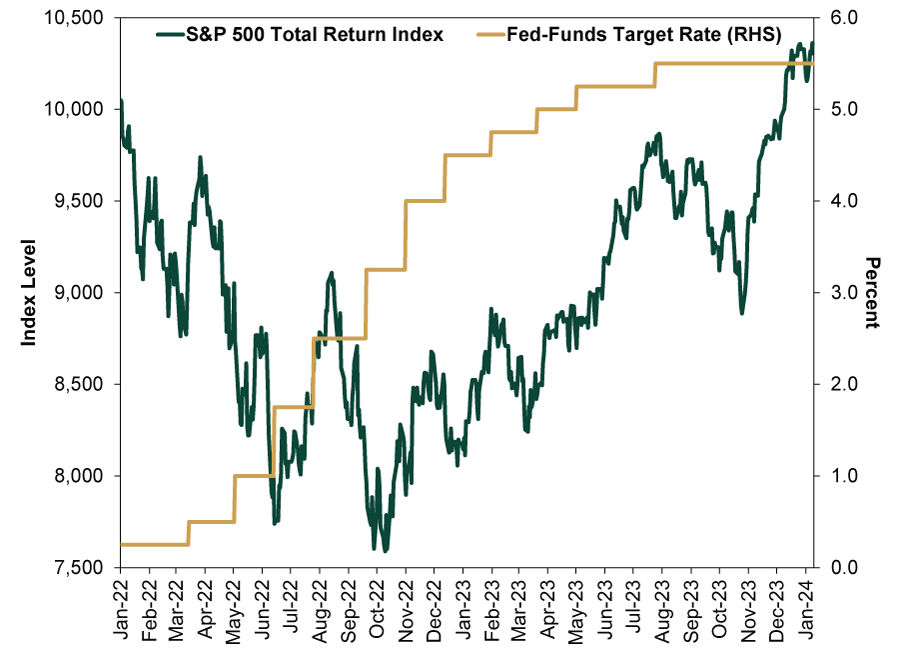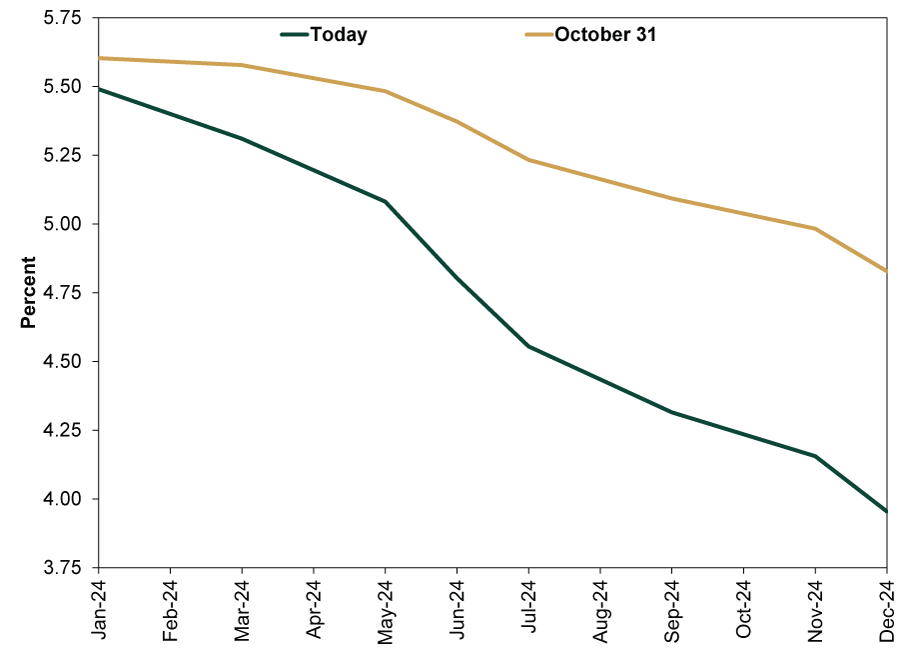Personal Wealth Management / Market Analysis
The Bull Market Doesn’t Depend on Rate Cuts
Don’t buy the narrative that Fed rate cut hopes are the only thing propping stocks up.
Are cuts coming? With every emerging data point on inflation, jobs and more, pundits launch a white-knuckled debate over what it means for potential Fed rate cuts. It all fits a common narrative: That this bull market depends on Fed policy, with the rally since autumn riding on the notion cuts are approaching, with only the timing unclear. But, in our view, this thinking overrates cuts’ impact. Markets don’t hinge on (unpredictable) monetary policy. The economy is more resilient than most think—and that is bullish for stocks.
Conventional wisdom holds “rate hikes bad, cuts good”—an apparent matter-of-fact investing truism hardly worth questioning. But just because it is repeated ad nauseum doesn’t make the truism, ummmm, true. Consider the last couple years of US rate hikes. (Exhibit 1) Stocks initially fell as they grappled with the Fed’s rapid rate U-turn from arguing inflation was “transitory” and didn’t require a shift in policy to hiking fast. Alongside other issues that roiled sentiment in 2022, this contributed to the bear market. But a new bull market began that October as stocks moved on. The recession rate hikes were supposed to induce failed to come.
Exhibit 1: Stocks Rose Through Rate Hikes
Source: FactSet, as of 1/12/2024. S&P 500 total return and fed-funds target rate (upper limit), 1/3/2022 – 1/11/2024.
But now, as inflation irregularly but swiftly cools, rate cut expectations are gathering steam. (Exhibit 2) In mid-December, fed-funds futures trading started pricing in rate cuts at the Fed’s March 20 meeting—and a more rapid pace thereafter. Supposedly, according to the financial press, this is the reason behind stocks’ latest leg up. Some pundits go further, saying if the Fed doesn’t cut rates there will be recession.
Exhibit 2: Markets Pricing in Earlier—and More—Rate Cuts
Source: CME FedWatch Tool, as of 1/12/2024.
But rate cuts aren’t necessary for growth—or the bull market. The bull market to date has been led by large growth firms, which generally don’t rely on bank lending for funding given the ample cash on their balance sheets. Rate cuts to re-steepen the yield curve and encourage loan growth are largely unnecessary to keep the growth-led rally going. (The yield curve shows the difference between short and long rates, and since banks borrow short and lend long—profiting from the difference—a steeper yield curve encourages lending.)
Now, rate cuts could boost credit-sensitive value stocks, and we are watching for this as a potential sign of an impending leadership shift. Commercial and industrial loans have fallen slightly year-over-year since October, down -1.0% y/y at 2023’s end.[i] If this picks up, possibly amid rate-cut enthusiasm, then value stocks could benefit. But business lending’s nascent dip probably isn’t significant for large growth stocks in Tech and Tech-like industries in other sectors.
We don’t think rate cuts are critical for the economy, either. National average savings deposit rates, representing a good chunk of banks’ funding costs, remain well below the effective fed-funds rate (0.46% vs. 5.33%)—and long rates (3.98%).[ii] This disconnect is why yield curve inversion since 2022 hasn’t caused deep credit contraction as many feared. In previous cycles, deposit rates were more closely linked to overnight fed-funds rates. Though banks’ funding costs are creeping higher as they compete for customers seeking more attractive rates, rising rates haven’t flowed through to depositors broadly, as banks remain awash with deposits overall. Rate cuts may help relieve the modest funding pressure banks face, but it isn’t as if the economy is starved of credit. So while cuts—and a steeper yield curve—may stir animal spirits, particularly among businesses that have retrenched thinking recession is around the corner, we doubt the economy and markets hinge on them like pundits imagine.
History also shows rate cuts aren’t the automatic bull fuel many believe. Just like rate hikes aren’t automatically bearish, there are other fundamental factors that drive stocks. Note the last three rate cut cycles (2000 – 2003, 2007 – 2008 and 2019 – 2020) coincided with falling stocks. Prior to that, cuts in the mid-1990s came alongside rising stocks. Before that, the Fed started cutting in mid-1989 and kept doing so through 1992. During this span, stocks initially rose, flipped into a bear market and started a new bull market. And prior to that, a rate cut cycle in the mid-1980s came amid overall rising stocks again.
Do you see any pattern? We don’t—just like hikes. Why? The Fed isn’t all powerful. Nothing it does has the ability to override economic cycles and how they relate to expectations. Those factors—to which the Fed may contribute at the margin—drive markets most of all.
The main takeaway we see from current rate cut obsession: All the focus on the Fed as the main factor driving stocks’ rally undersells the economy’s fundamentals—sentiment is still skeptical. But if rate hikes never drove recession to begin with, we fail to see why a lack of rate cuts will now. The economy is already proving it can handle this level of rates just fine.
When fear of a false factor—rate cut uncertainty—is prevalent, it shows reality is better than appreciated. Rather than fret what central banks will or won’t do as headlines blare about this or that consequence, investors should take the pervasive handwringing as bullish. After all, to paraphrase Sir John Templeton’s famous quote, bull markets grow on skepticism.
[i] Source: Federal Reserve Bank of St. Louis, as of 1/12/2024. Commercial and Industrial Loans, All Commercial Banks, 12/27/2023.
[ii] Source: Federal Reserve Bank of St. Louis and FactSet, as of 1/12/2024. National Deposit Rates: Savings, December 2023, Federal Funds Effective Rate and 10-year Treasury yield, 1/11/2024.
If you would like to contact the editors responsible for this article, please message MarketMinder directly.
*The content contained in this article represents only the opinions and viewpoints of the Fisher Investments editorial staff.
Get a weekly roundup of our market insights
Sign up for our weekly e-mail newsletter.

You Imagine Your Future. We Help You Get There.
Are you ready to start your journey to a better financial future?

Where Might the Market Go Next?
Confidently tackle the market’s ups and downs with independent research and analysis that tells you where we think stocks are headed—and why.







